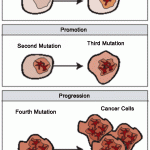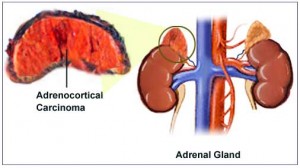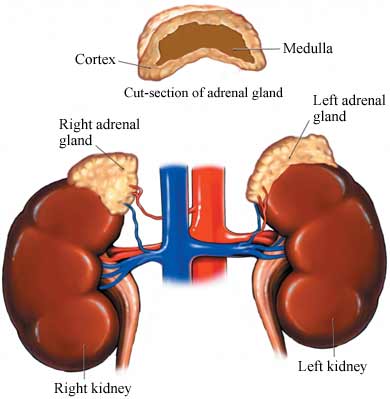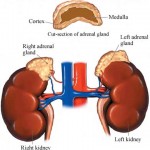What are the adrenal glands?
The adrenal glands are small glands that are located just above each kidney (they are sometimes called the suprarenal glands for that reason). The adrenal glands are surrounded by a layer of connective tissue and a layer of fat. They are triangular in shape and consist of several distinct parts:
The central part of the gland is called the adrenal medulla and has a gray-white appearance. It produces the chemicals epinephrine (also called adrenaline) and norepinephrine. Both of these chemicals are involved in regulation of the nervous system. Epinephrine controls the short-term stress response (aka fight-or-flight response). While norepinephrine also plays a role in short-term stress response, it functions in regulating mood and attention, as well.
The outside part of the gland surrounding the medulla is the adrenal cortex, which has a yellow appearance. This part of the adrenal gland is largely responsible for producing steroid hormones in the body. There are several types of steroid hormones that are produced by the adrenal glands. Mineralocorticoids (such as aldosterone) are steroid hormones that help regulate the salt levels in the body by controlling the absorption and excretion of salt and water in the kidneys. This in turn helps to regulate blood pressure. Glucocorticoids (such as cortisol) are steroid hormones that play a critical role in the regulation of sugar within the body. These hormones also help to regulate the fat stores within the body, act as a strong anti-inflammatory force, and play an important role in fetal development, particularly in lung maturation. The adrenal cortex also produces several sex steroid hormones, including androgens (critical for male sexual development) and precursors to estrogen (critical for female sexual development).
What are adrenal tumors, and what types of adrenal tumors are there?
 Normally, cells in the body will grow and divide to replace old or damaged cells. This growth is highly regulated, and once enough cells are produced to replace the old ones, normal cells will stop dividing. Tumors occur when there is an error in this process, and cells continue to grow in an uncontrolled manner. Tumors can either be benign or malignant. Although benign tumors can grow in an uncontrolled way, they do not spread to other parts of the body (metastasize), nor do they invade surrounding tissues. Malignant tumors (also known as cancers) will grow uncontrolled in such a way that they invade and damage other tissues around them. They also gain the ability to break off from where they start and spread to other parts of the body, usually through the blood stream or through the lymphatic system where the lymph nodes are located (a process known as metastasis).
Normally, cells in the body will grow and divide to replace old or damaged cells. This growth is highly regulated, and once enough cells are produced to replace the old ones, normal cells will stop dividing. Tumors occur when there is an error in this process, and cells continue to grow in an uncontrolled manner. Tumors can either be benign or malignant. Although benign tumors can grow in an uncontrolled way, they do not spread to other parts of the body (metastasize), nor do they invade surrounding tissues. Malignant tumors (also known as cancers) will grow uncontrolled in such a way that they invade and damage other tissues around them. They also gain the ability to break off from where they start and spread to other parts of the body, usually through the blood stream or through the lymphatic system where the lymph nodes are located (a process known as metastasis).
The most common tumor of the adrenal gland is actually a benign tumor called an adrenal adenoma. In most patients, these benign tumors never cause a patient to have any symptoms and do not need to be treated. They are usually found when a patient has a CT (or CAT) scan of the body for an unrelated reason, and are thus sometimes called “incidentalomas”. The most common malignant tumors found in the adrenal gland are tumors that come from cancer cells that have metastasized (or spread) from other parts of the body to the adrenal gland through the blood stream. Several different types of cancer may spread to the adrenal glands, most commonly melanomas, lung cancers, and breast cancers. The adrenal glands are the fourth most common site in the body for cancer cells to metastasize to, after the lungs, liver, and bone.
 Cancers can arise directly within the adrenal glands themselves; however, these are relatively rare. Cancers may arise directly from the adrenal cortex, and are called adrenal cortical cancers. These cancers can either be functioning (meaning they secrete excess steroid hormones) or non-functioning (meaning they do not secrete steroids). Functioning adrenal cortical cancers are more common than non-functioning cancers. Cancers can also arise within the adrenal medulla, the most common of which are pheochromocytomas. In children, neuroblastoma tumors can develop within the adrenal medulla. Pheochromocytomas and neuroblastomas are discussed elsewhere individually, will not be discussed further in this review.
Cancers can arise directly within the adrenal glands themselves; however, these are relatively rare. Cancers may arise directly from the adrenal cortex, and are called adrenal cortical cancers. These cancers can either be functioning (meaning they secrete excess steroid hormones) or non-functioning (meaning they do not secrete steroids). Functioning adrenal cortical cancers are more common than non-functioning cancers. Cancers can also arise within the adrenal medulla, the most common of which are pheochromocytomas. In children, neuroblastoma tumors can develop within the adrenal medulla. Pheochromocytomas and neuroblastomas are discussed elsewhere individually, will not be discussed further in this review.
Other types of adrenal cancers can occur, such as lymphoma; however, these cases are rare.
What are the signs of adrenal cortical tumors?
Both adrenal adenomas and adrenal cortical cancers can produce excess steroid hormones, producing symptoms, which lead to further workup and the identification of the tumor. Symptoms vary depending on the steroid that is produced. If too much aldosterone, which is a type of steroid hormone, is produced, Conn’s syndrome (also known as primary hyperaldosteronism) can develop. Conn’s syndrome most commonly occurs with pituitary adenomas, but it can also occur in the setting of adrenal hyperplasia (an overgrowth of normal adrenal cortical tissue) and adrenal cortical cancers. Signs of Conn’s syndrome include elevated blood pressure, decreased levels of potassium in the blood, and decreased levels of a chemical produced by the kidneys called renin in the blood. In most cases of Conn’s syndrome, elevations in blood pressure are mild to moderate. Other symptoms include weakness, muscle cramps, increased thirst, and increased frequency of urination.
 Cortisol is a separate steroid hormone produced within the adrenal cortex. If a tumor produces excess cortisol, Cushing’s syndrome (also known as hypercortisolism) can develop. This syndrome is seen not only with adrenal tumors, but can also be the result of excessive levels of adrenal cortical stimulating hormone (also known as ACTH, a hormone that is responsible for stimulating the adrenal glands to produce cortisol) produced by the pituitary gland or another tumor in the body. Cushing’s syndrome may also develop in patients who are taking steroids as medication for other disorders. The symptoms of Cushing’s syndrome can vary greatly from patient to patient and involve a number of different parts of the body. Symptoms include weight gain and water retention resulting in a round face and collection of fat on the back of the shoulders and neck (so-called “buffalo hump”). Red or purple stretch marks, known as striae can appear on the skin. Excessive hair growth (called hirsutism) can also be seen. Excessive cortisol levels can interfere with the body’s immune system predisposing a patient to unusual infections. Patients with Cushing’s syndrome are at high risk for development of diabetes. Patients may also have mental changes, including mood swings, irritability, and in the worst case, psychotic episodes. In children, excessive cortisol can lead to premature sexual development and maturation (also called precocious puberty).
Cortisol is a separate steroid hormone produced within the adrenal cortex. If a tumor produces excess cortisol, Cushing’s syndrome (also known as hypercortisolism) can develop. This syndrome is seen not only with adrenal tumors, but can also be the result of excessive levels of adrenal cortical stimulating hormone (also known as ACTH, a hormone that is responsible for stimulating the adrenal glands to produce cortisol) produced by the pituitary gland or another tumor in the body. Cushing’s syndrome may also develop in patients who are taking steroids as medication for other disorders. The symptoms of Cushing’s syndrome can vary greatly from patient to patient and involve a number of different parts of the body. Symptoms include weight gain and water retention resulting in a round face and collection of fat on the back of the shoulders and neck (so-called “buffalo hump”). Red or purple stretch marks, known as striae can appear on the skin. Excessive hair growth (called hirsutism) can also be seen. Excessive cortisol levels can interfere with the body’s immune system predisposing a patient to unusual infections. Patients with Cushing’s syndrome are at high risk for development of diabetes. Patients may also have mental changes, including mood swings, irritability, and in the worst case, psychotic episodes. In children, excessive cortisol can lead to premature sexual development and maturation (also called precocious puberty).
Adrenal tumors may also cause excess production of sexual hormones. If excess testosterone is produced, virilization can occur in either men or women. Virilization causes increased masculine characteristics, resulting in deepened voice, loss of hair, and increase in the size of the clitoris in women. Feminization may occur in men with excess estrogen production, and may cause sexual impotence and/ or breast growth (gynecomastia).
Adrenal tumors may also cause symptoms by occupying space in the abdomen. Patients with large adrenal tumors may experience feelings of abdominal fullness or localized pain. Patients may feel as though they are quickly full when eating and may experience weight loss. In some cases of large adrenal tumors, patients may actually feel a mass in their abdomen.

